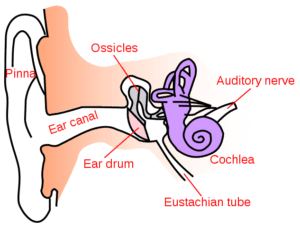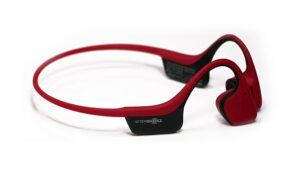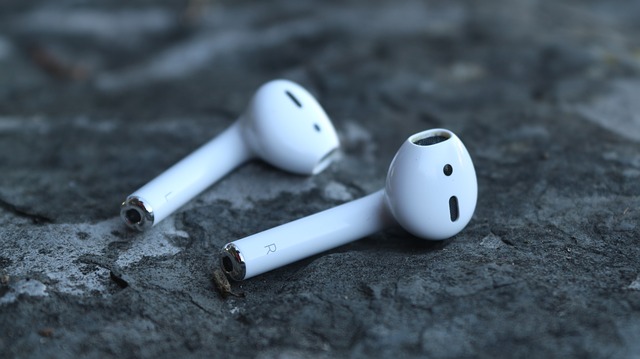How Do Bone Conduction Headphones Work
Table of Contents
If you’ve never come across a bone conduction headphone, you may mistake it for a piece of sci-fi brain-sensing device. A bone conduction headphone straps across the back of your head with the earpiece resting on your cheekbones.
Without an earcup or earbud covering your ear, you’ll be able to take in both ambiance sound and the audio projected by the bone conduction headphone. This newer breed of headphones is already gaining a following amongst specific groups of the public.
What Is Bone Conduction All About

Bone conduction is an unconventional method of sound sensing by humans. In typical conditions, humans pick up sounds when vibrating molecules transfer the energy to the eardrum.
The eardrum, which is a thin piece of membrane, picks up the vibration and transmit the sound to the cochlea. The cochlea then turns the sound into electrical impulses and transmits the information to the brain.
What makes bone conduction different is that sound vibrations are transmitted via the jaw or cheekbones to the cochlea, bypassing the eardrum completely. The sound, in the form of vibration, travels from the facial bones (jaw/cheekbones) to the inner temporal bones before arriving at the cochlea.
While bone conduction may sound intriguing, it has been around for centuries. It is believed that bone conduction was discovered by the famed musician, Ludvig Van Beethoven. Beethoven, who suffered from hearing disability, connects a rod to the piano to pick up the notes via bone conduction.
How Bone Conduction Headphones Work
Unlike typical headphones, the bone conduction headphone does not cover your ear. Neither does it has a diaphragm-based driver. A bone conduction headphone uses a vibrational transducer to transmit sound vibration through cheekbones.
The bone conduction headphone is often shaped like a headband that hinges on the top of the ear. When you put on the headphone, the sound transducer is rested towards the cheekbone. The objective of a bone conduction headphone isn’t to produce sounds that travel through the air but sending vibration via solid bone structures.
While bone conduction headphones are relatively new, the technology has been applied in military and healthcare. Bone conduction devices serve as hearing aids to those who have a hearing disability due to eardrums impairment. In fact, technology has been applied in non-commercial applications for a few decades.
Are Bone Conduction Headphones Safe?

There is a misconception that using a bone conduction headphone is safer than typical earbuds or headphones. With that said, it is also unfair to claim that bone conduction headphones are hazardous to the listener.
The technology itself is harmless, as proven by its use in medical aids. However, the nature of its usage may lead to hearing losses amongst users. While the bone conduction headphone bypasses the eardrum, audio sensory still involves the cochlea.
Hearing damages often occur when the cochlea is exposed to prolonged sound that is above a certain level. Excessive noise can also damage hearing nerves, which may lead to temporary or permanent hearing damages.
Like a conventional headphone, you shouldn’t increase the volume of the bone conduction headphone to an excessive level. The safety of using headphones, bone conduction or not, is ultimately dependent on the users.
Is The Bone Conduction Headphone For You?
As sleek as putting on a bone conduction headphone can be, it is not designed to fit every group of users.
The primary advantage of bone conduction headphones is that you’re still able to pick up ambiance sound while listening to the audio. This makes it ideal for joggers and cyclists who need to be constantly alert to their surroundings.
Bone conduction headphones are also a natural fit for people with hearing disabilities. If you’ve been relying on hearing aids, using bone conduction allows you to enjoy listening to music in the best way possible.
You may also find the bone conduction headphone a good fit if you’re irritated by having earbuds stuffed into your ear.
Check out this guide to choose the right headphone for you.
How Does A Bone Conduction Headphone Sound Like?
It’s hard to explain how bone conduction headphones sound like. However, you can experience the difference with bone conduction by blocking your ears and speaking in usual tones. Note that the ambiance sound has diminished while you’ll still be able to pick up your voice.
The sound that you’ve picked up via bone conduction is different from hearing through eardrums. It just doesn’t have the same quality or richness in the tone. Again, this doesn’t mean that a bone conduction headphone will sound bad. It’s just different.
Technically, bone conduction will not produce the same bass quality as a regular headphone. Some users have also claimed that bone conduction headphones may suffer from distortion at certain frequencies.
If you’re a passionate audiophile who needs nothing but perfectly rich audio, the bone conduction headphone is not for you. However, if you’re looking for a headphone that allows you to take in the surrounding sound, you ought to get one.
Bottom Line
It’s important to have a realistic expectation of bone conduction headphones. Instead of being attracted to its sleek designs or claims of safety, only choose a bone conduction headphone if it truly serves your needs.


